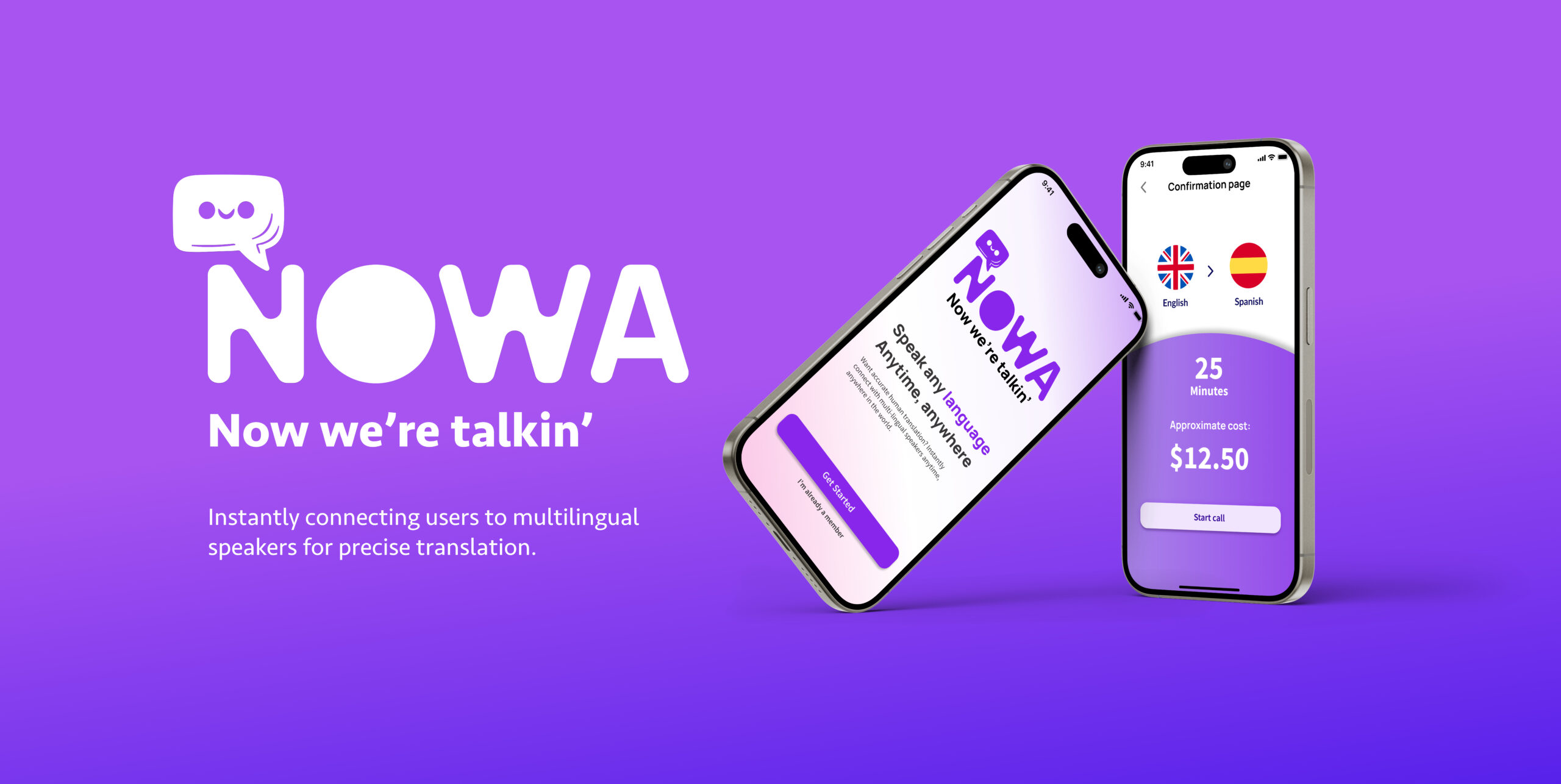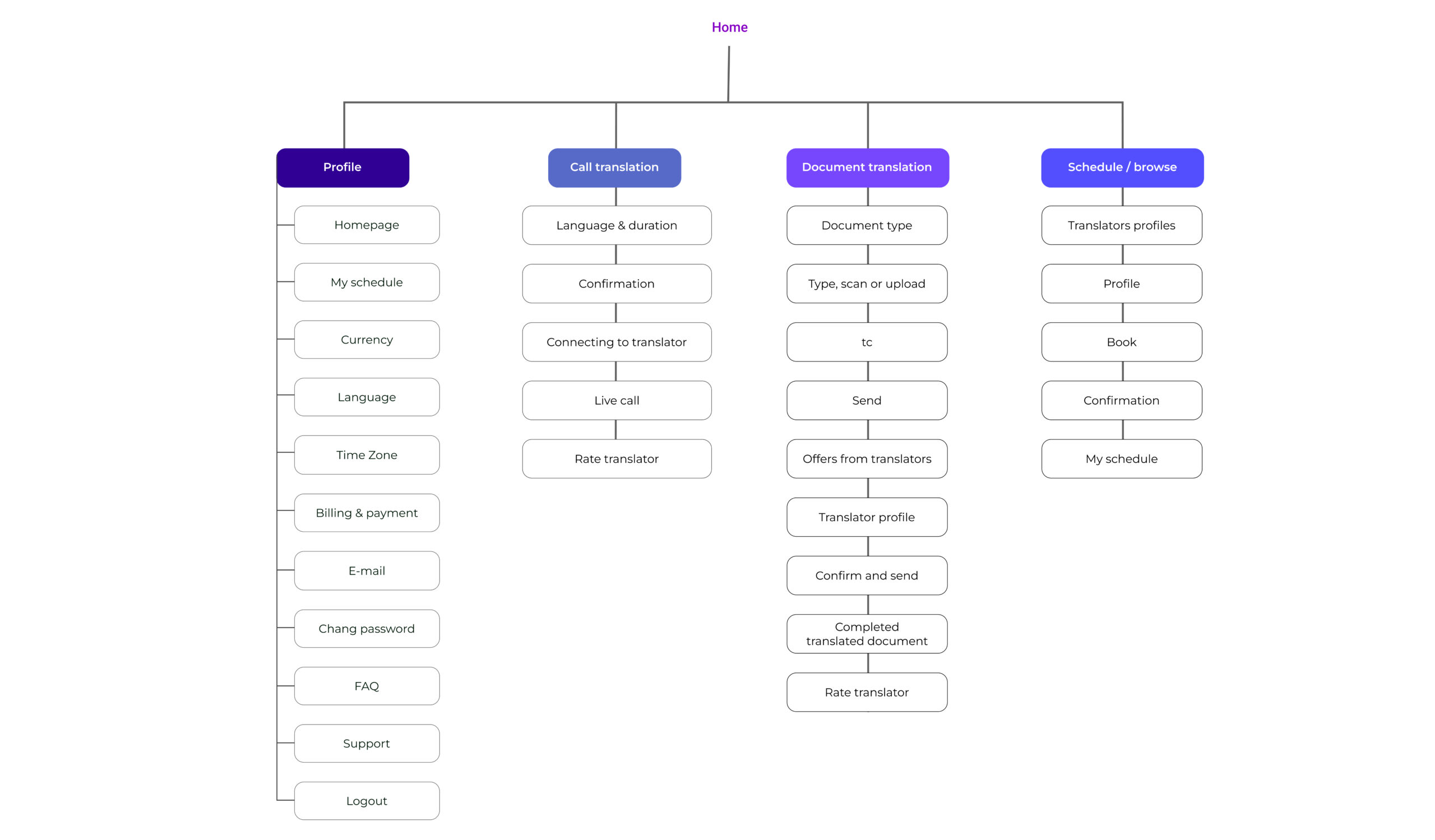

My Role
Timeline
PROBLEM
Language barriers cause misunderstandings, anxiety and frustrations
Automated translation tools have improved but still struggle with nuances and cultural context, leading to inaccuracies that can cause costly misunderstandings in critical situations like business, legal, and healthcare interactions. Hiring a professional translator is also costly and time-consuming.
THE SOLUTION
Instant human translation for precise conversations
A platform which you can instantly connect to real translators for precise communication, while multilingual speakers can earn an extra income. Merging technology with human proficiency, providing quick, efficient and accurate communication, instilling confidence in users.

WHITE PAPER RESEARCH
Human Translators vs. Automated Tools
While researching effective translation solutions, I examined various studies on translation accuracy and user satisfaction. I came across a compelling statistic from a recent study by Nimdzi Insights that highlights the advantages of human translators:
COMPETITIVE ANALYSIS + THE GAP
Automatic translators produce inaccuracies. Hiring a professional is tedious and expensive.
Automated tools like Google Translate and DeepL are fast but often lack accuracy with nuanced language. Platforms like Upwork and Gengo offer professional translators, but the process can be slow and costly.

USER INTERVIEWS
Interviewees showed a 3x preference for human translation over automated tools.
Research shows that accurate and fast translation is essential, so I interviewed 8 individuals living in non-native language environments, including expats, students, and travelers. I asked the following questions to identify common pain points with existing solutions and then organized the findings through affinity mapping.
RESEARCH QUESTIONS:
- Share a recent experience you had with language barriers.
- How do you feel when you’re unable to communicate with someone due to language barriers?
- How do you currently overcome language barriers in life?
- Do you use translation services or tools? How do you find them to be?
- How important is accuracy to you when it comes to translation?
THE MAIN INSIGHT
Based on trends in my affinity map, I observed that without quick and accurate translation options, users often struggle with confidence and productivity, leading to frustration and missed opportunities.
Theme 1: Speed
The need for quick translations often outweighs the desire for perfection, leading users to accept errors.
Users often waste time verifying translations and correcting errors, which detracts from their primary tasks.
Users seek instant translations for travel and business emergencies, making speed a top priority.
Theme 2: Accuracy
Most interviewees feel more confident bringing a friend or relative to help translate rather than going alone with an automated translation tool.
7 out of 8 interviewees said they experienced awkward moments due to translation tools producing inappropriate results.
Users struggle with not being able to check translation accuracy themselves, leading to errors being discovered too late.
Theme 3: Productivity
Interviewees often avoid tasks that require translations, limiting their productivity and opportunities for growth.
The complexity of language barriers often causes users to procrastinate, delaying important tasks due to the fear of making mistakes or misunderstanding others.
Users often feel guilty about imposing on others for not being able to speak their language.

32 Years Old | Data Analyst
User story
Hey! I’m Adam, an American expat living and working in China. I love exploring new places and learning about other cultures. As a newcomer to the country, I’m still learning the language and navigating daily interactions. My lack of proficiency in Chinese does make life a little more challenging whether it’s communicating with colleagues, ordering food, or exploring the city. I hope that I’ll be able to fully integrate into society here as I plan to stay be here a while!
Goals
- Learn Chinese for better communication
- Integrate into Chinese society
- Explore new experiences in China
Motivation
- Professional success and effectiveness in his job
- Social integration and connection with the local community
- Personal growth and exploration of new cultures and experiences
Pain points
- Difficulty in daily communication due to language barriers.
- Feeling isolated from the local culture and community.
- Challenges in navigating daily life tasks such as ordering food or transportation without proficiency in Chinese.
PROBLEM STATEMENT
Adam Miller is an American expatriate in China who needs to apply for a residence card at his local city office because he needs an ID to open a bank account.
USER JOURNEY MAP

SITE MAPPING

USER FLOW
DESIGN
Setbacks + a new direction for translation assistance
Initially, I explored three ideas: Augmented Reality Translator, Crowdsourced Translation Assistance, and Real-World Language Immersion Game.
Initial Ideas Considered:
- Augmented Reality Translator:
Uses AR to overlay subtitle translations on real-time conversations. - Crowdsourced Translation Assistance:
Users submit texts for translation, which are then reviewed and refined by a community of bilingual volunteers. - Real-Time Language Immersion Game
Players earn points by recording and uploading real-world interactions in foreign languages, such as conversations or activities
While each had potential, I found that AR could be cumbersome in daily use, crowdsourced translation faced scalability and consistency issues, and a game might not provide the immediate, accurate translations users need. Ultimately, I chose an app that connects users with multilingual speakers on demand for its practicality and effectiveness in addressing language barriers directly.




TESTING + IMPROVEMENTS
3 major improvements in my design

SCREENS
The final product
Instant Call Translation
Document Translation
Browse & Schedule Translator


Style Guide

Link to my full Figma work file here
CONCLUSION + LESSON LEARNED
Designing the app concept to connect users with bilingual speakers for accurate translations has been a rewarding project, addressing gaps in authenticity and cultural relevance often missed by automated tools.
Successes
User-Centric Design: An intuitive interface met users’ needs effectively.
Cultural Accuracy: Feedback confirmed potential for nuanced translations.
Real-Time Connections: Explored seamless communication workflows.
Challenges and Lessons Learned
Speaker Availability: Highlighted the need for advanced scheduling.
Scalability: Emphasized planning for user demand.
Improvements
Early Feedback: Start user testing sooner to refine the user journey.
AI Matchmaking: Focus on designing smarter user-translator pairing systems.
Streamlined Workflows: Enhance workflows for translators and users based on usability testing.
Comprehensive Documentation: Improve design documentation to support development handoff.
This project underscored the importance of user-centered design in bridging communication gaps. As a UX designer, my role focused on crafting an intuitive interface, gathering and analyzing user feedback, and ensuring the design supports scalability and accessibility.
For more work inquiries email me at contact@emitanimura.com
Thank you for reading! ᵔ ᵕ ᵔ